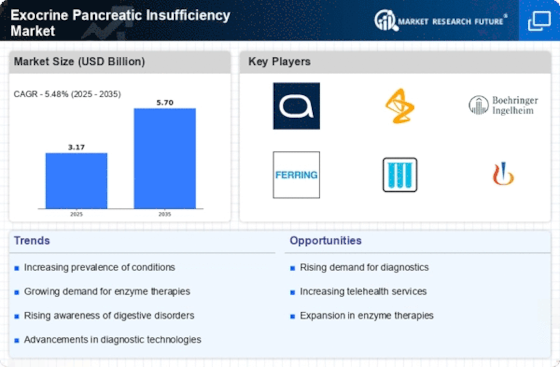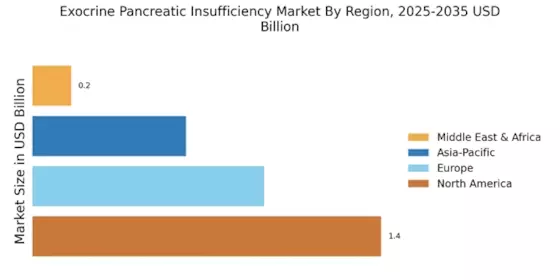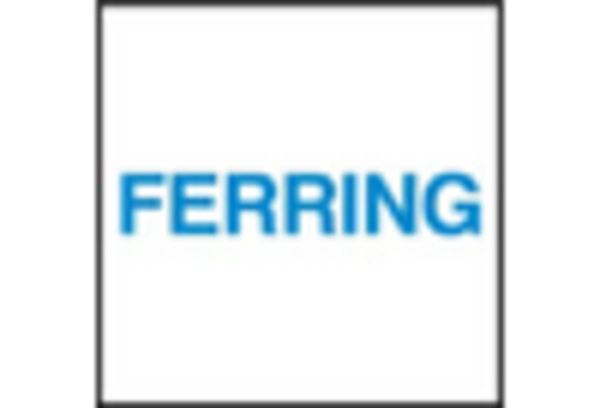Expansion of Patient Support Programs
The expansion of patient support programs is emerging as a key driver in the Exocrine Pancreatic Insufficiency Market. These programs aim to provide education, resources, and emotional support to individuals diagnosed with EPI. As awareness of EPI grows, healthcare providers and organizations are establishing initiatives to assist patients in managing their condition effectively. Such programs often include counseling, nutritional guidance, and access to treatment options, which can significantly improve patient adherence to therapy. The presence of robust support systems may lead to better health outcomes and increased patient satisfaction. As more healthcare entities recognize the value of these programs, their proliferation is likely to contribute positively to the overall market landscape for EPI management.
Rising Focus on Nutritional Management
Nutritional management is becoming increasingly recognized as a vital component in the treatment of Exocrine Pancreatic Insufficiency Market, thereby influencing the Exocrine Pancreatic Insufficiency Market. Patients with EPI often face challenges in nutrient absorption, leading to malnutrition and weight loss. As healthcare providers emphasize the importance of tailored dietary interventions, the market for nutritional supplements and specialized diets is expected to grow. Recent studies suggest that a significant percentage of EPI patients benefit from dietary modifications, which can enhance their quality of life. This focus on nutritional management not only addresses the symptoms of EPI but also supports overall health, indicating a holistic approach to treatment. Consequently, the increasing demand for nutritional products and services is likely to drive market expansion.
Growing Demand for Enzyme Replacement Therapy
The demand for enzyme replacement therapy is a crucial factor driving the Exocrine Pancreatic Insufficiency Market. Patients suffering from EPI often require pancreatic enzyme replacement therapy (PERT) to aid digestion and improve nutrient absorption. The market for PERT has seen substantial growth, with estimates indicating a compound annual growth rate (CAGR) of over 5% in recent years. This growth is attributed to the increasing recognition of the importance of managing EPI effectively. Pharmaceutical companies are actively investing in research and development to create more effective enzyme formulations, which may enhance patient compliance and treatment outcomes. As awareness of EPI and its management continues to rise, the demand for PERT is likely to expand, further propelling the market forward.
Technological Advancements in Diagnostic Tools
Technological innovations in diagnostic tools are significantly influencing the Exocrine Pancreatic Insufficiency Market. Enhanced imaging techniques, such as magnetic resonance imaging (MRI) and endoscopic ultrasound, allow for more accurate detection of pancreatic dysfunction. Additionally, the development of non-invasive tests, such as stool elastase testing, has simplified the diagnostic process, making it more accessible to patients. As these technologies become more widely adopted, the rate of diagnosis for EPI is expected to increase, leading to a larger patient base in need of treatment. The integration of artificial intelligence in diagnostic procedures may further streamline the identification of EPI, potentially improving patient outcomes and driving market growth. This trend indicates a shift towards more precise and efficient healthcare solutions, which is likely to benefit the Exocrine Pancreatic Insufficiency Market.
Increasing Prevalence of Exocrine Pancreatic Insufficiency
The rising incidence of Exocrine Pancreatic Insufficiency Market (EPI) is a pivotal driver for the Exocrine Pancreatic Insufficiency Market. Conditions such as cystic fibrosis, chronic pancreatitis, and pancreatic cancer contribute to the growing number of patients diagnosed with EPI. Recent estimates suggest that approximately 1 in 10 individuals with chronic pancreatitis may develop EPI, indicating a substantial patient population requiring management. This increasing prevalence necessitates the development and availability of effective treatment options, thereby propelling market growth. Furthermore, as healthcare systems enhance their diagnostic capabilities, more cases of EPI are likely to be identified, further expanding the market. The need for specialized therapies and nutritional support for these patients underscores the importance of addressing EPI within the healthcare framework.


















Leave a Comment